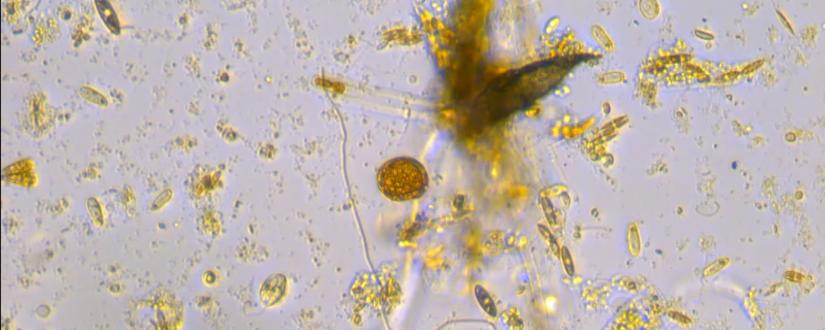Among the thousands of microalgal species that inhabit our oceans some produce toxins harmful to human health.
- Potent toxins produced by some microalgae can accumulate in the food web and, when consumed by humans, cause serious illnesses
- Scientists tested the hypothesis that forms of these microalgae, usually found attached to surfaces, may be able to expand their range by being transported via seaweed “rafts” in the East Australian Current

Microalgal community from 'raft' showing Coolia palmyrensis, large brown cell in the middle.
The range of some of these marine microorganisms is expanding but, until now, exactly how those forms usually attached to surfaces might disperse has remained largely unknown.
An opportunity to test the hypothesis that harmful surface associated microalgal species could travel long distances using seaweed and seagrass “rafts” has confirmed that the East Australian Current (EAC) is more than a “highway” for Nemo and friends.
PhD candidate Michaela Larsson from the UTS Climate Change Cluster said that what they looked for were “epibenthic dinoflagellates” which refers to a group of microalgal species that are usually found associated with sediments or on the surface of seaweeds and seagrasses.
“We’d already ruled out the likelihood that viable cells of these organisms could be dispersed suspended in ocean currents because an analysis of plankton samples collected over 50 years failed to reveal their presence,” Larsson says.
Larsson says that reading Thor Heyerdahl’s “The Kon-Tiki Expedition” sparked an idea about “rafting”.
“It struck me that these otherwise sedentary organisms could be dispersed across large distances via rafting on detached filaments/strands of seaweed and seagrasses,” she says.
The team had a one off opportunity to test this hypothesis during a voyage on the CSIRO Marine National Facility RV Investigator in 2015. During this voyage, they collected drifting seaweed and seagrass fragments from the EAC and identified the associated microalgal communities to see if epibenthic dinoflagellates could remain linked with these ‘rafts’ once transported offshore.
“Viable cells of potentially harmful dinoflagellates from the genera Coolia, Amphidinium and Prorocentrum were found associated with rafts therefore revealing rafting as a potential vector for dispersal of these organisms,” Larsson says.
Phylogenetic analyses confirmed the presence of Coolia palmyrensis on a drifting Sargassum sp. raft, the first report of this potentially harmful epibenthic dinoflagellate species in temperate Australian waters.
Further investigation is needed to confirm if viable cells of these organisms can be delivered to shallow coastal waters and successfully colonise new coastal habitats.
The researchers say that managing the risk to human health from toxin producing microalgae will require monitoring their diversity and abundance as well as ecological research to understand whether their distribution is changing. The research is published in Marine Ecology Progress Series.
Funding:
ARC, PADI Foundation, Australian Government Research Training Program

